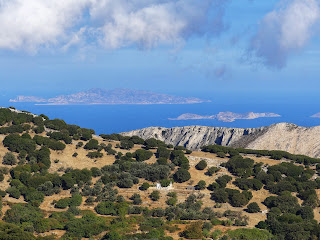Seems that the more common islands that tourists visit are Mykonos and Santorini. All the classic white white buildings are from Santorini that you see, however white buildings are pretty much ubiquitous all over Greece and so are brightly colored doors and shutters. We didn’t want to go where a cruise ship would be docked.
Interesting to note that when we spoke of our intention to go to Naxos to Greeks they roundLy approves and said that it has more to offer.
First the geology: thanks to Jim we have our research assistant helping with the information on this front in response to sending a pic of a rock.
This place is famous for its marble, second only to Paros a nearby island, in the purity of its white marble. There are jagged lines of who knows what all over. Visually it’s gorgeous.
Interspersed are man-made stone walls, presumably for keeping sheep and goats. There s actually an entire town that is built from marble here even the streets. We have a guidebook who notes that marble is a cold stone and the homes are freezing in the winter.
We hope to visit a marble quarry tomorrow.
Interesting to note that when we spoke of our intention to go to Naxos to Greeks they roundLy approves and said that it has more to offer.
First the geology: thanks to Jim we have our research assistant helping with the information on this front in response to sending a pic of a rock.
This place is famous for its marble, second only to Paros a nearby island, in the purity of its white marble. There are jagged lines of who knows what all over. Visually it’s gorgeous.
Interspersed are man-made stone walls, presumably for keeping sheep and goats. There s actually an entire town that is built from marble here even the streets. We have a guidebook who notes that marble is a cold stone and the homes are freezing in the winter.
We hope to visit a marble quarry tomorrow.
Also could be sulfides in Granite or veins and the red Murcury ore, Cinnabar (/ˈsɪnəbɑːr/) or cinnabarite (/sɪnəˈbɑːraɪt/), likely deriving from the Ancient Greek: κιννάβαρι[6] (kinnabari), refer to the common bright scarlet to brick-red form of mercury(II) sulfide (HgS) that is the most common source ore for refining elemental mercury, and is the historic source for the brilliant red or scarlet pigment termed vermilion and associated red mercury pigments.
Associated modern precautions for use and handling of cinnabar arise from the toxicity of the mercury component, which was recognized as early as in ancient Rome.[20] Because of its mercury content, cinnabar can be toxic to human beings. Overexposure to mercury, mercurialism, was seen as an occupational disease to the ancient Romans. Though people in ancient South America often used cinnabar for art, or processed it into refined mercury (as a means to gild silver and gold to objects) "the toxic properties of mercury were well known. It was dangerous to those who mined and processed cinnabar, it caused shaking, loss of sense, and death. Data suggests that mercury was retorted from cinnabar and the workers were exposed to the toxic mercury fumes."[21][page needed] "Mining in the Spanish cinnabar mines of Almadén, 225 km (140 mi) southwest of Madrid, was regarded as being akin to a death sentence due to the shortened life expectancy of the miners, who were slaves or convicts






Comments
Post a Comment